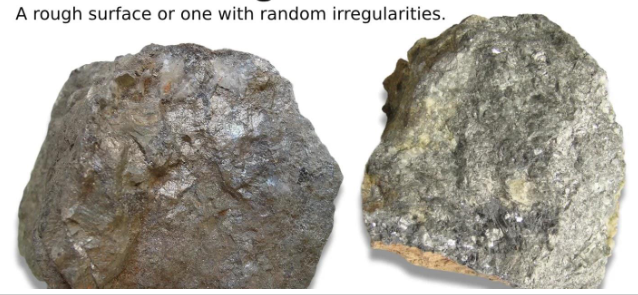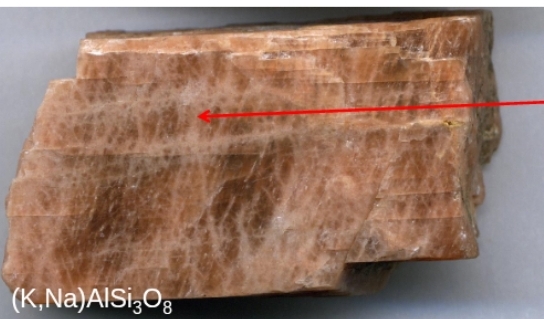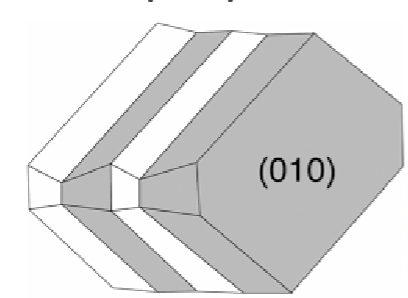Earth Science (Minerals 1)
1/44
There's no tags or description
Looks like no tags are added yet.
Name | Mastery | Learn | Test | Matching | Spaced |
|---|
No study sessions yet.
45 Terms
Igneous Rock (intrusive)
Formed from the cooling and solification for magma or lava and minerals begins to crystallize.
Sedimentary rock
formed from deposits of pre-existing rocks that accumulate on Earth's surface. If sediment is buried deeply, it becomes compacted and cemented forming a rock
Metamorphic rock
Formed when existing rocks are changed by heat, pressure
Mineral
Naturally occurring, inorganic solid made of elements
arranged to form a crystalline structure. They have defined
chemical formula and characteristic physical properties that all
geologists can test and observe to identify them
Naturally occuring
inorganic solid
crystalline
narrowly-defined chemical coposition
characteristic physical property
Magma
Molten rock/liquid in the earth’s crust
Lava
liquid/molten rock above the earth’s crust
Mineral Lustre
The way a mineral interacts with light
Metallic Lustre
Reflects all light, can be shiny or dull like a metal. Has a strongly colored streak
Non metallic mineral lustures
Transmits or absorbs some light, let’s it pass through surface. Has white, light or no colored streak
Mineral hardness
It is determined by rubbing a mineral of unknown hardness against one of
known hardness or vice versa.
Mohs scale (relative hardness 1 to 10), absolute hardness values (0 - 100)
Mineral fracture
The way a mineral breaks in a more or less random pattern with no smooth planar surfaces.
Uneven/Irregular fracture
A rough surface with irregular breaks, with no reflection of light

Conchoidal fracture
Smooth, curved, rippled planar surface, like a seashell, which reflects light.

Cleavage fracture
Flat smooth planes
Reflects light uniformly
Planes
The flat parallel sides of a mineral
Mineral streak
The color of the powder produced when a mineral is rubbed or scraped across a hard, unglazed surface like a streak plate
(Greater than 6.5 on the hardness scale)
Crystal habits of a mineral
the characteristic external shape or form of a mineral which is determined by its atomic structure
Mineral density
refers to the mass of minerals contained within a specific volume of a mineral or a substance.
Mineral hardness less than 2.5
If your finger nail can leave a scratch on the mineral
Greater than mohs scale hardness of 5.5
Leaves a scratch mark on glass surface
Diagnostic property
a single property that helps you quickly identify a mineral
Exsolution Lamalle
Color variation in orthoclase,
Occurs only in minerals whose compositions vary between two or more pure end member compositions – like K or Na

Schiller Effect
Iridescent
Silicate
SiO
most abundant element which makes up the earth’s crust
(Example: Quartz, SiO2)
Lustre of Silicate
This mineral always has a non-metallic lustre
Streak of Silicate
The streak of this mineral is always white, pale grey, none at all
Non-ferromagnesian Silicate
SiO
does not contain iron and magnesium
Color of non-ferromagnesian silicate
The color of this mineral is light
Ferromagnesian Silicate
SiO which contains Fe and/or Mg
(example: Olivine, (Fe,Mg)²SiO4
The color of Ferromagnesian Silicate
The color of this mineral is usually dark green, brown or black
Sulphides
S (Pyrite FeS²)
Lustre of Sulphide
This mineral will always have a metallic lustre
Streak of Sulphide
The streak of this mineral is always grey
Oxide
O (Example: Magnetite Fe³O4).
Lustre of Oxide
This mineral is considered metallic even if it has an earthy lustre
Streak of Oxide
This mineral’s streak is reddish brown or dark grey/black
Sulphates
SO4 (Example: Gypsum CaSO4.2H²O)
Halides
Contains F (Flouride), CI (Chloride), Br (Bromide), I (Iodide), At (Astatine)
Example: Halite, NaCI
Diagnostic property of Halides
Softness, between 2.5 and 5.5 on the mohs scale
Streak of Halides & Carbonates
The streak color of this mineral is generally white
Native elements
One single element, (Example: Graphite, C)
Carbonates
CO³ (Example: Calcite CaCO³)
Diagnostic property of Carbonates
This mineral will react with acid
Phosphate
PO4 (Example: Apatite, CA5(PO4)³F
Albite Twinning
A set of parallel lines on a certain crystal, seen on cleavage faces like albite and labradorite
